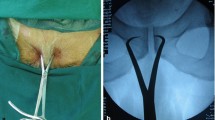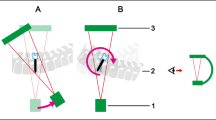Abstract
Background:
The mobile SIREMOBIL® Iso-C3D C-arm is a device that permits the intraoperative three-dimensional (3-D) representation of bony structures (multiplanar reconstructions). Linking to navigation makes it possible to transfer the generated 3-D data directly to the navigation system. The advantages of CT-based navigation with 3-D representation of bone structures are therefore combined with the advantages of inherent navigation with intraoperative imaging. The surgical instrument is immediately displayed in the image, i.e., without any complex manual registration procedure.
Patients and Methods:
Inherent navigation in 3-D images from the Iso-C3D was successfully used for the first time in this study in a larger group of patients. 39 patients who intraoperatively underwent successful navigation in Iso-C3D images were included in the study.
Results:
143 drilling procedures were performed in the 39 patients. Pedicle instrumentations took place in 24 of the 39 patients. Eight patients underwent screw placements on the pelvic ring (sacroiliac joint screw placement, placement of anterior column screw, acetabulum osteosynthesis). Four patients underwent retrograde perforation of a talus cyst and filling with autologous cancellous bone, while one patient underwent screw osteosynthesis on the neck of the femur, and two patients underwent placement of an external fixator with a hinge at the elbow joint. One pedicle screw was found to be 2 mm out of position in the spinal group. All other screws/drillings were placed correctly. Additionally, in three patients intraoperative navigation had to be aborted due to hard- or software problems. In these cases, surgery was finished in conventional ways.
Conclusion:
The results herein for the extremities, spine, and pelvis are very encouraging and portend an advance in safety and quality in the operating room (OR). As compared to the conventional approach and other computer-assisted procedures (CT-based navigation, C-arm-based 2-D navigation), the lowest rate of incorrect placements and the lowest average fluoroscopy time were achieved during the placement of pedicle screws on the spine with Iso-C3D navigation at a comparable average OR duration. Iso-C3D navigation supports standardized work procedures in the OR.
Similar content being viewed by others
Author information
Authors and Affiliations
Corresponding author
Rights and permissions
About this article
Cite this article
Gruetzner, P.A., Waelti, H., Vock, B. et al. Navigation Using Fluoro-CT Technology. Eur J Trauma 30, 161–170 (2004). https://doi.org/10.1007/s00068-004-1328-6
Received:
Accepted:
Issue Date:
DOI: https://doi.org/10.1007/s00068-004-1328-6




